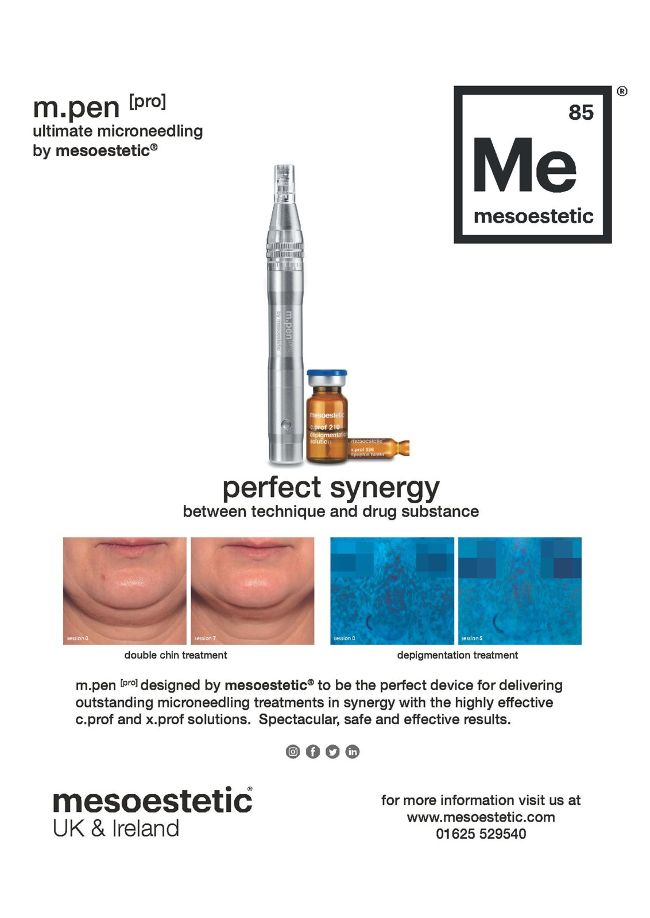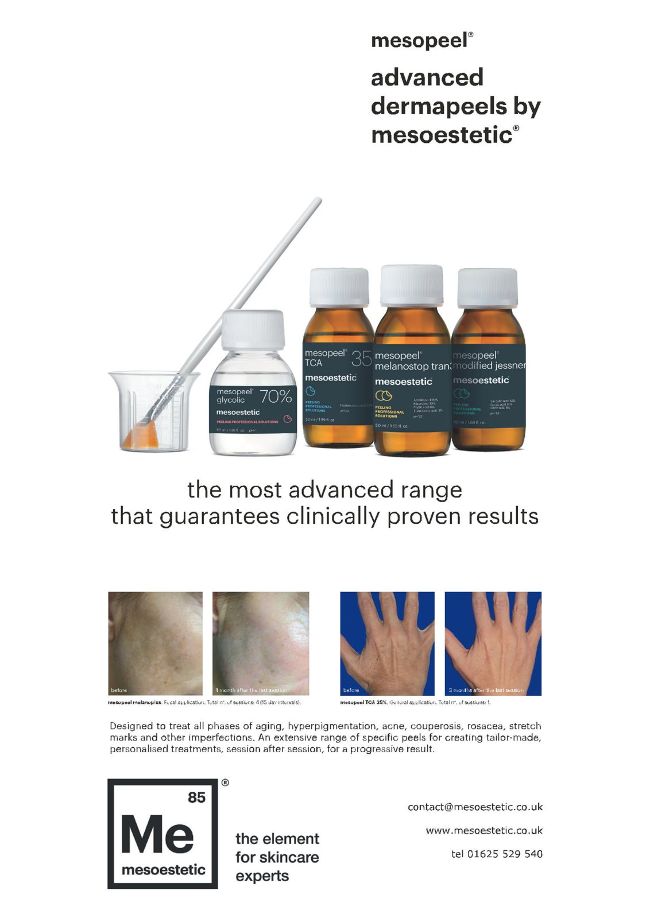CLINICAL
Let’s get to the bottom of it
Following an extensive four-year review of clinical data, new technology and techniques, the British Association of Aesthetic Plastic Surgeons (BAAPS) has published its Superficial Gluteal Lipofilling (SGL)guidelines. We speak to one of the authors of the document, Dr Omar Tillo, and US plastic surgeon Dr Daniel Del Vecchio, who led extensive clinical research, about the topic.
In 2018, BAAPS dissuaded all its members from performing Brazilian Buttock Lift (BBL) surgery, until more data could be collated, due to the high death rate associated with the procedure.
Gluteal fat grafting is currently the procedure with the biggest growth rate in plastic surgery worldwide, with an increase of around 20% year-on-year. It has become the most popular means of buttock volume augmentation, overtaking gluteal augmentation with implants. In 2020, The Aesthetic Society statistics recorded 40,320 buttock augmentation procedures, which included both fat grafting and buttock implants.
In 2015, there were reports of intraoperative mortality related to pulmonary fat emboli associated with BBL surgery and, with growing concern about the high mortality rate associated with this procedure, three years later BAAPS recommended it was not performed by its members.
Stimulated by new evidence based on scientific review and analysis, BAAPS guidelines now recommend that SGL is safe to perform under two key conditions:
1. Injection into the subcutaneous plane only – the evidence shows that only death from fat embolisms has been when fat was injected into the deeper muscle layer. (Note that death in general has been reported due to reasons other than fat embolism, such as infection and bowl perforations)
2. Intraoperative ultrasound must be used during the placement of fat in the gluteal area to ensure that the cannula remains in the subcutaneous plane – this is the only way that surgeons can be confident they are not in the muscle layer.
Clinical Research
Following concerns over the safety of the BBL procedure highlighted on an international scale, US plastic surgeon Dr Daniel Del Vecchio led extensive clinical research, reviewing large amounts of science and data to fully understand the cause of BBL dangers. At the Cadogan Clinic on Sloane Street, he talks through his findings.
“I don’t know if I had any involvement in the BAAPS guidelines, but I can just tell you the facts,” opens Dr Del Vecchio. “From 2019 to 2022, I published about five or six papers with different groups, as a lead author. We looked at what happens when you put the fat in. Where did the fat go?”
Dr Del Vecchio found that if you put the fat in the muscle, it goes right through the muscle: “Just like you get with a pot roast, when the beef separates on the fork, the fat just goes through the muscle and into the veins and it breaks the veins. If you stay above the membrane fascia of the muscle, like when you eat a steak, you’re in the subcutaneous fat of the buttock, there’s no way the fat will go through that fascia and you can put as much fat as you want in the butt, and get up to really high pressures. That membrane is the key, and we proved that the fat in the subcutaneous space was completely safe.
“In days of yore in the early two thousands, people thought that the muscle was like a sausage casing, that you put the fat in and the muscle would expand, but it wouldn’t go anywhere because there was a membrane around the muscle. For example, biceps, forearms and calf muscles have a membrane that goes all the way around them because they are extremity muscles. They have a membrane that goes all the way around them because they’re extremity muscles. However, the muscles on the trunk only have the membrane on one side – this is something that anatomists have known for years, but, because it wasn’t surgically relevant, people didn’t pay attention to it. There’s no fascia on the underside of this muscle. It’s like a sieve, so once you get under the fascia, it’ll go right through the muscle underneath to the vessels. We proved that and we proposed that if you just stay subcutaneously, you’ll be fine.
It’s one thing to theoretically say you’re over the muscle, but how do you know? “That’s where the ultrasound probe came in. It’s smaller than an iPhone – you put it on the skin, you put the cannula in and in two seconds, you can see that it’s right over the muscle, and over the membrane too. The other thing we realised is that fat migrates. If fat is under the membrane, it migrates through the muscle. I said ‘what if you put it under the skin and step on a pedal and pump it in?’ I noticed with the ultrasound, the fat was moving. I said, ‘let’s just do static insertion, allow it to migrate and then take the cannula out, put it in another area, and do the same thing’. Then at the end, you just smooth it out. You’re not putting fat in at this point, you’re just vibrating it. Now it’s faster, it’s safer and you get better projection because you’re putting the fat in one place and allowing it to build up. We wrote guidelines which came out in September, called Practice Advisory and Gluteal Fat Grafting in which we said that ultrasound is the way to go. The other thing we said was the surgeon should do three cases maximum per day, and your surgeon should do all the surgery, meaning the liposuction and the fat grafting.”


Frequently Asked Questions
Consultant plastic surgeon and medical director of the Creo Clinic Dr Omar Tillo is one of the authors of the SGL guidelines and explains why the new directions were needed.
WHY DO YOU THINK THESE GUIDELINES WERE NEEDED?
Dr Tillo: BBL continues to be the fastest growing in popularity amongst all cosmetic surgery procedures, as women and men continue to seek to contour the midriff area of the body into a curvy, aesthetically pleasing waist and hips.
Plastic surgeons in the UK were told by BAAPS in 2019 not to perform this surgery due to its high risk of complications. However, more recently, laboratory and clinical studies showed that gluteal lipofilling can be done safely.
Due to the complexity of this surgery, a list of important clinical and technical considerations should be adhered to, otherwise many serious complications can occur. With the ban in the UK, there were increasing concerns about more patients turning to medical tourism or non-regulated facilities to have this surgery, putting their health and lives at risk. For this reason, I continued to voice my opposition to the ban and argued the urgency to adopt these guidelines, to allow a safe way of performing this procedure in the UK.
WHEN PUTTING TOGETHER THE GUIDELINES, DID YOU ENCOUNTER ANY RESISTANCE?
Dr Tillo: Of course, there was strong resistance from colleagues within the profession due to the bad reputation that BBLgained overthe years. Some of the opposition stemmed from safety concerns about the risks of this surgery which drove the moratorium in the UK.The second reason forthe opposition continues to be the misconception about the aims and outcome of this surgery, seen by the public and many professionals, as achieving the exaggerated buttock enlargements portrayed by some celebrities in the mainstream and social media.
WHAT MAKES THE BBL PROCEDURE PARTICULARLY RISKY?
Dr Tillo: This procedure combines multiple techniques, steps, and skills in the way the fat is removed, processed, prepared then transferred. Multiple clinical and technical steps must be performed to the highest standards to avoid major complications. In addition, because this procedure is relatively new, there has been no standardised way of performing many of these steps safely and effectively, therefore each surgeon was trying or inventing their own ways of performing them. We now know that the margin for errors in this procedure is very narrow and mistakes can lead to serious consequences. For example, injuries and complications can happen during liposuction, such as bowel perforations or skin necrosis, or fat transfers at the wrong level causing severe nerve injuries, paralysis, fat embolism and death. Not paying attention to sterility can end up causing severe infections, sepsis, and necrotising fasciitis. Patients turning in theatre can cause injuries to nerves, eyes, and blindness. The process needs to be flawless, like running a Formula 1 team, to avoid major accidents.
WHY DO SO MANY PATIENTS GET THE PROCESS DONE ABROAD?
Dr Tillo: A very few patients might seek specialised and niche procedures abroad that may not be provided in the UK. Those patients often do extensive research and target highly qualified and skilled surgeons that are likely to provide good care. However, most patients seeking plastic surgery abroad are incentivised by the low cost. There are vital details that patients are unlikely to be aware of until it’s too late after surgery. For example, communication and language barriers, standards of practice and regulations, types of equipment used, medications, and aftercare. In the UKwe have multiple authorities controlling and regulating surgical activities and you need to spend a lifetime learning about every single regulation or standard – forget about checking them all via a google search. From a professional viewpoint, price-driven medical tourism is no different than handing a knife to a random person in the street and asking them to perform plastic surgery on you.
BBL, in particular, would be the worst gamble to take, considering the long list of problems and complications that can occur with any omission or shortcut in care.
HOW CAN CLIENTS ACHIEVE THE SAME RESULTS MORE SAFELY?
Dr Tillo: We have now identified that the safest way of doing a BBL is the superficial gluteal lipofilling (SGL) with ultrasound scan guidance, which I introduced to the UK in July 2020 and called it the BEST-F technique (Buttock Enhancement with Superficial Transfer of Fat). Using this technique, it is possible to transfer large amounts of fat safely into the subcutaneous space. Up to 1 litre or more can be transferred to each buttock and hip. Once all settled and partial fat absorption is completed, this would achieve a noticeable significant enhancement of the waist, hips, and buttocks within the natural aesthetic beauty standards.
The days of transferring two or three litres of fat into the muscle of the buttock aiming to achieve the exaggerated BBL have passed. However, if a patient wants an exaggerated look, this can still be done by repeating the superficial transfer. In other words, doing it in stages.
WHICH OTHER PROCEDURES MAY NEED SIMILAR GUIDELINES AND WHY?
Dr Tillo: Most plastic surgery procedures have been around long enough to be studied extensively and regulated. For example, BAAPS has recently published some excellent guidelines on liposuction.
I believe that any new surgical procedure or even non-surgical treatment, such as energy devices, should be scrutinised much more strictly and carefully than the current standards. For example, many non-surgical treatments are driven by unproven claims and theories and find their way easily into the practice without any, or little, evidence about their clinical efficacy. We continue to see trends of treatments driven by aggressive marketing techniques, fall into the abyss a few years later. I believe that this part of the industry is capitalising on giving false hopes and promises to vulnerable patients and should be stopped.